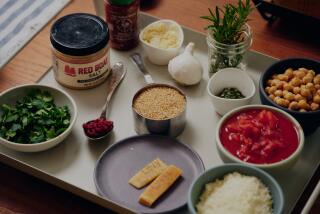How to Retain Maximum Vitamin Content in Vegetable Soup
Question: Are the vitamins in the vegetables in soups âruinedâ by cooking? If so, whatâs the value of eating them in soup? A family controversy has erupted over the nutritional quality of hot (not the cold-style) soups.
Answer: Some loss of vitamins is unavoidable in any food preparation, particularly in cooking. Soups made with vegetables can still be a good source of vitamins and other nutrients, provided they are properly prepared. Here are some tips to retain maximum vitamin content in soups when using vegetables.
When using fresh vegetables, use them as soon as possible. Considerable vitamin loss occurs in wilted and dehydrated vegetables. When using spinach and other greens, wash them under running cold water to remove all sand, never allow them to soak in warm water. When using frozen vegetables in soups, preliminary thawing is not necessary and adding them still frozen avoids loss of water-soluble vitamins. Liquid in canned vegetables may be added.
In addition to losing some vitamins when peels are discarded, the cutting, chopping or grinding of vegetables exposes more surfaces to air which in turn releases enzymes that oxidize and destroy vitamins such as Vitamin A. To minimize the loss, use the cut vegetables promptly.
Long, slow cooking is more destructive than rapid cooking for a brief period. To quickly destroy enzymes in vegetables that oxidize vitamins, add the vegetables to rapidly boiling water. Stirring of foods also tends to increase the rate of oxidation. Tightly covering the utensil when cooking or storing leftovers preserves nutritive value, particularly Vitamin C. When sauteing before boiling in soup, avoid using rancid fats since these affect Vitamins A and E.
Soup is a good to way get needed water-soluble vitamins and minerals. Extremely soluble in water are Vitamin C and thiamine; only slightly soluble are riboflavin and niacin, which are found in green vegetables. Avoid the use of alkaline baking soda (some people use it to retain the green color of vegetables and shorten cooking time) because it can destroy Vitamin C, niacin and riboflavin.
Q: Having an electric stove, I find myself constantly cleaning and scrubbing the removable chrome bowls underneath the electric coils. Are these bowls really necessary? Can you give some tips on their care and how to avoid staining them?
A: Although most people often think of them as decorations, these reflector bowls serve to catch spills, provide even cooking and conserve energy by reflecting heat into the cooking pan. Here are some suggestions from the Whirlpool Home Appliance service center:
Stains (blue/gold and brown) occur from overheating, cooked-on food spills and incorrect cleaning methods. Overheating is caused by using a pan larger than the surface unit, using pans with flat bottoms, using the high heat setting for a long period of time, using specialty utensils such as woks and tea kettles that do not have flat bottoms and also using foil liners.
Always use a lower heat setting to cook the food, starting with a high setting and finishing off with a low. If not, the extra heat goes to the reflector bowl, which then gets too hot and turns blue or gold. The stains caused by overheating may not be removable.
To prevent spills and splatters do not overfill pans. Brown spill stains may be removed if treated promptly. To clean chrome trim rings and one-piece chrome bowls, use warm soapy water or soapy steel-wool pads. Use commercial oven cleaner only on those rings that are badly stained. Never place them in a self-cleaning oven.
Address questions on food preparation to You Asked About, Food Section, The Times, Times Mirror Square, Los Angeles 90053. Personal replies cannot be given.

